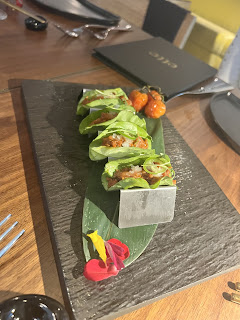My most recent post covered the role of the Phoenicians in the spread of wine across the Mediterranean. As was the case for Iranian wine, production in the Levant contracted with the introduction of Islam to the region, with wine permitted only for use by Christians in the course of their religious pursuits.
The "modern" phase of the Lebanese wine industry began in 1857 with French Jesuit monks who settled in the Bekaa Valley in the mid-19th century. This group was gifted a 25-acre plot of land in the Bekaa and chose to employ it in grape-growing. Thus was born Chateau Ksara, an enterprise still in existence today.
The early wines were made for personal consumption with the monks moving from raisin-based wines to wines made from grapes grown on Cinsault, Carignan, and Grenache vines imported from Algeria, at that time the biggest wine hub outside of France.
At the end of the First World War, the Ottoman Empire was dismantled and Lebanon was placed under a French Protectorate. This brought in a large number of French soldiers and Administrators and drove up the demand for wine. Chateau Ksara switched from wines for personal use to a commercial enterprise in order to meet this demand.
In the early 1970s the Vatican issued a papal edict requiring that the Catholic Church sell any and all commercial concerns. This forced the Jesuits to sell Chateau Ksara to a Lebanese investment group in 1973.
At the beginning of the Lebanese Civil War (1975 -90) a total of six commercial wineries were operational within the country. At the end of the war, Chateaus Kefraya, Ksara, Musar, and Nakad and Domaine des Tourelles, plus six new producers, dusted off the sands of war and turned their full attention to the resurrection of the Lebanese wine industry. By the mid-1990s, the number of wineries had grown to 14 and to 60 by 2018. The country was conducive to grape growing, with a dry, sunny climate and protection of the vines afforded by the peaks of the Lebanon and Anti-Lebanon Mountains.
The characteristics of the Lebanese grape-growing environment are shown in the chart below.
Chateau Musar: One of The North Stars of Lebanese Wine
One of most enduring stories of Lebanese wine has been the efforts of Chateau Musar's Serge Hochar to produce wine during the course of the Civil War. I had the honor and priviledge of tasting the estate's wines with him prior to his untimely death. The below observations are from notes taken at the tasting.
Chateau Musar's vineyards are located in Lebanon's Bekaa Valley with red and white wine grapes grown in distinctly separate environments. The red wine grapes -- Cabernet Sauvignon, Cinsault, and Carignan -- are planted in the southern portion of the Bekaa Valley on soils that are gravel over limestone. These old vines yield between 30 and 35 hl/ha. The white varieties are the indigenous Obaideh and Merwah which are planted in high-altitude (1500 m ) vineyards. Grape growing is organic and, at harvest, the berries are hand-picked by Bedouin tribespeople and trucked over the mountain to the winery which is 2.5 hours removed.
Grapes for the red wines are fermented by varietal in cement vats and then racked into French oak barriques after 6 months (In the tasting, Serge indicated that he had tried stainless steel fermentation but that it had "destroyed" the wines. He uses stainless steel for some of the younger-generation wines but exclusively uses concrete for the Hochar and Musar wines.). The barrique wines are blended after 12 months of initial residence and then returned to the barriques for an additional 12 months. The mature wine is then bottled unfiltered and aged for 3 - 4 years before being released to the market.
The white wines are fermented in French oak for 6 - 9 months before blending and bottling and are then stored in the Musar cellars for an additional 6 years prior to market release.
By 2020, this Lebanese winemaking renaissance had been brought to heel by:
- A popular revolution
- A financial crisis -- loss of 95% of the value of the Lebanese pound
- The impact of the coronavirus
- A massive explosion in the Beirut port which killed in excess of 200 people, wounded over 6000 people, and dealt a massive blow to the port infrastructure and adjacent business/residential districts
- Rising poverty
- A fuel and electricity crisis.
These conditions served to cause a contraction in both the local (30 - 35% decline 2020 over 2019) and export (30% decline) wine markets. Wine imports have decreased by 65%. Wine producers are hit especially hard by these conditions because they need hard currency to import equipment, sulfur, yeast, bottles, corks, and labels.
Given the need for hard currency, as well as the limited local consumption, Lebanese winemakers will be forced to focus on the export market in order to survive. The prospects are better for establishments with name recognition in foreign markets as marketing funds are not readily available.























































